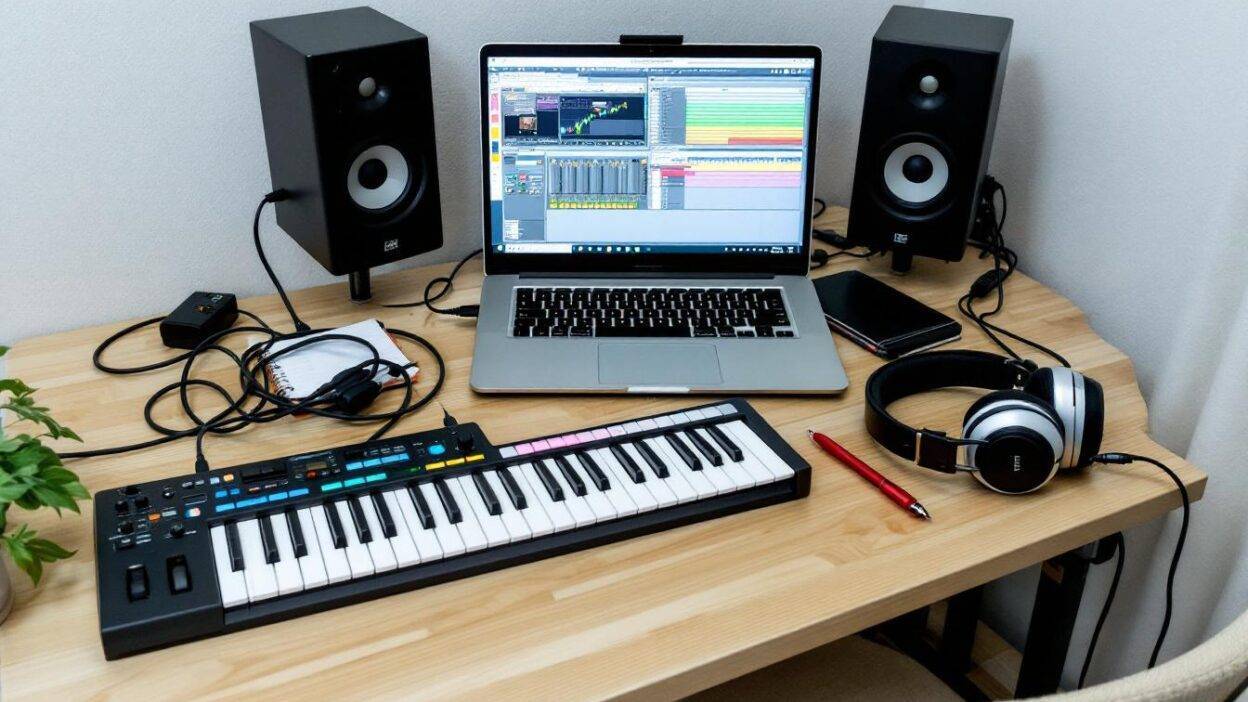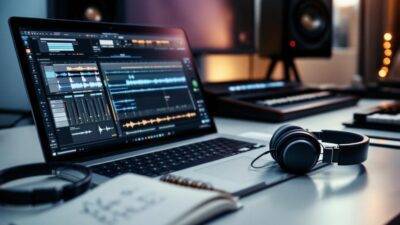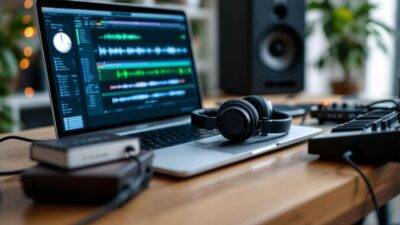Starting your journey in music production can be overwhelming. At Edm, we’ve compiled essential music production advice to help beginners navigate this exciting field.
Our guide covers everything from setting up your home studio to mastering the basics and developing an efficient workflow. Whether you’re a complete novice or have some experience, you’ll find valuable tips to enhance your skills and creativity.
How to Set Up Your Home Studio
Selecting Your Digital Audio Workstation
Your Digital Audio Workstation (DAW) forms the core of your studio. Popular options include Apple Logic Pro for mainstream audio production and Apple GarageBand for Mac recording on a budget. Each offers unique strengths, so test demo versions to find the best fit for your workflow. Ableton Live stands out in the EDM community for its intuitive interface and powerful live performance features.
Essential Hardware for Beginners
Start with the basics: a reliable computer, audio interface, and studio monitors or headphones. The Focusrite Scarlett 2i2 serves as an excellent audio interface, providing top-notch sound quality at an affordable price. For monitoring, consider the KRK Rokit 5 G4 speakers, which offer balanced sound ideal for beginners. If budget constraints exist, invest in quality headphones like the Audio-Technica ATH-M50x.
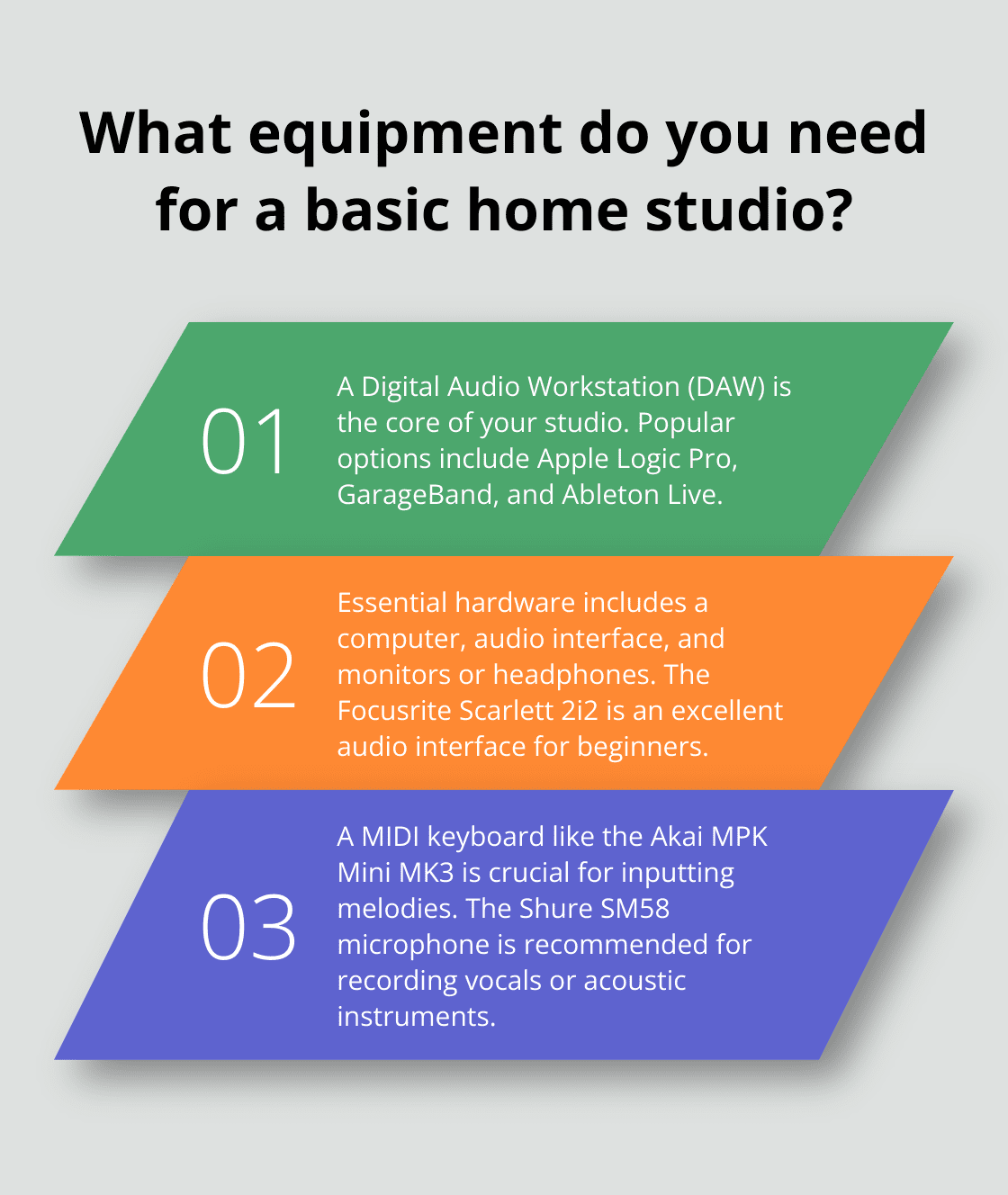
A MIDI keyboard proves essential for inputting melodies and chords. The Akai MPK Mini MK3 (compact and feature-rich) fits perfectly in small studio spaces. Include a decent microphone if you plan to record vocals or acoustic instruments. The Shure SM58 (an industry standard) provides excellent quality without breaking the bank.
Optimizing Your Listening Environment
Your room’s acoustics significantly impact sound perception. Position your monitors at ear level, creating an equilateral triangle with your listening position. Use acoustic panels to address early reflections and bass traps for low-frequency issues. Mount your acoustic panels flat on the walls and spread them evenly throughout the entire room for maximum effectiveness.
Choose a room with minimal outside noise for your studio. Avoid square rooms if possible, as they can create problematic standing waves. Use a rug or carpet to reduce floor reflections, and maintain a clutter-free workspace to minimize unwanted sound reflections.
Your studio setup will evolve as you grow as a producer. Begin with the essentials and upgrade gradually as you identify your needs. A solid foundation sets the stage for creating professional-sounding tracks.
As you establish your home studio, the next step involves mastering the fundamentals of music production. Let’s explore the key concepts that will elevate your skills and creativity in the following section.
Mastering Music Production Basics
Music Theory for Producers
Music theory forms the backbone of production. Start by learning notes, scales, and chords. These elements form the building blocks of any piece of music. The major and minor scales are essential, as they form the basis of most Western music. Familiarize yourself with common chord progressions like I-V-vi-IV, which appears in countless hit songs.
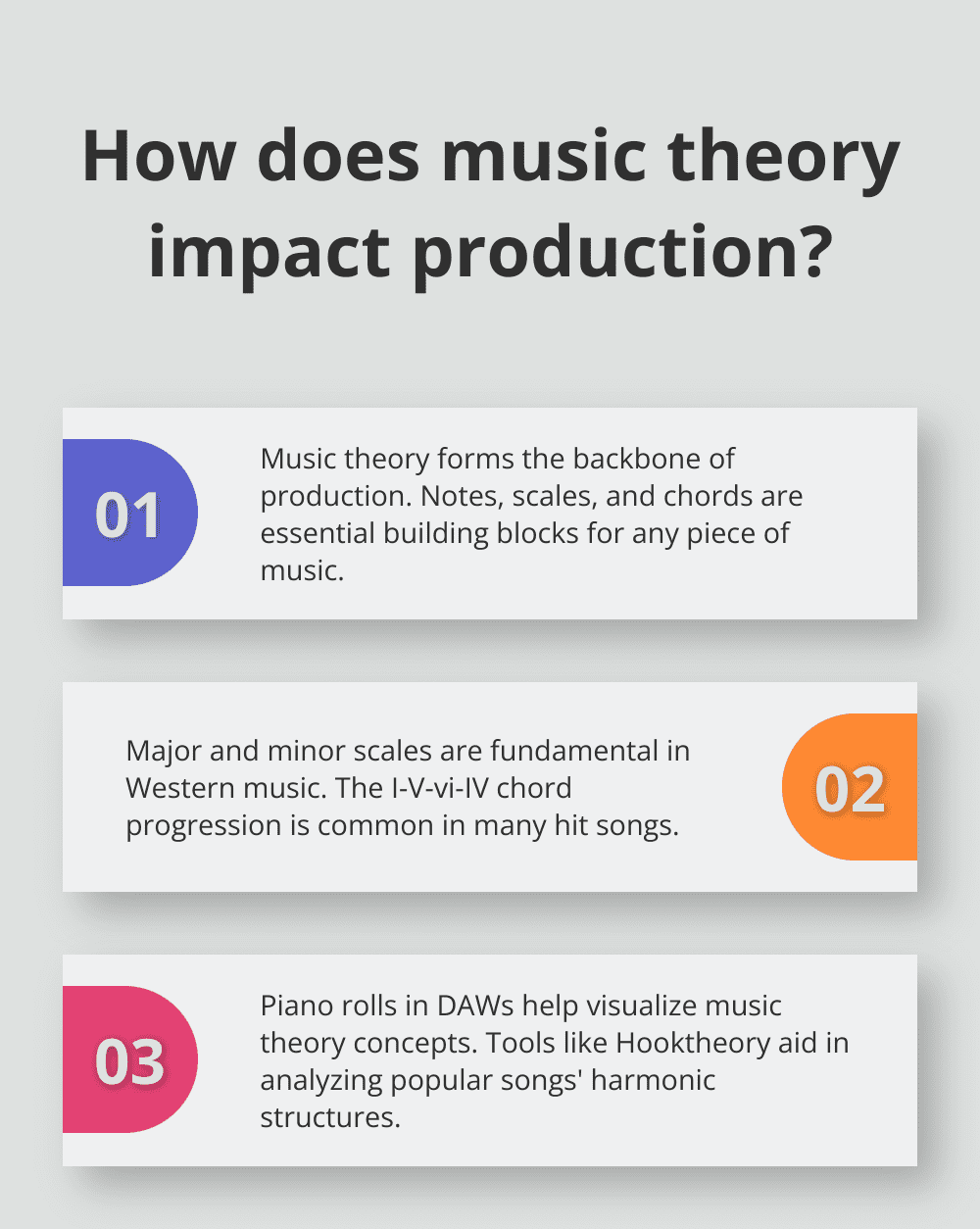
Use a piano roll in your DAW to visualize these concepts. Experiment with different chord voicings to add depth to your productions. Tools like Hooktheory can help you analyze popular songs and understand their harmonic structure.
Sound Design Essentials
Sound design allows your creativity to shine. Begin with subtractive synthesis, which underpins many synth sounds. Learn to manipulate oscillators, filters, and envelopes to shape your sounds.
Experiment with different waveforms. Sine waves excel for sub-bass, while saw waves suit leads and pads. Layer sounds to create rich textures. For example, combine a saw wave with a sine wave to create a full-bodied lead.
Don’t avoid presets. They serve as excellent learning tools. Analyze preset patches in synths like Serum or Massive to understand how complex sounds are built.
Rhythm and Arrangement Techniques
Rhythm is the heartbeat of your track. Start by understanding basic time signatures, with 4/4 dominating electronic music. Practice programming drum patterns using a step sequencer in your DAW.
Layer different drum sounds to create depth. For instance, layer a punchy kick sample with a sub-heavy one to create a powerful, full-spectrum kick drum.
When it comes to arrangement, structure is key. Study the arrangements of tracks in your genre. Most EDM tracks follow a structure similar to: Intro – Build-up – Drop – Breakdown – Build-up – Drop – Outro.
Use automation to create interest throughout your track. Automate filters, effects, and volume to guide the listener through your song’s journey.
These basics are just the beginning. As you progress, you’ll develop your unique style and workflow. Keep experimenting and break the rules when inspiration strikes. The next step is to streamline your production process, which we’ll explore in the following section on building an efficient workflow.
How to Streamline Your Music Production Workflow
Organize Your Digital Workspace
Create a logical folder structure for your projects. Separate your samples, projects, and exports into distinct folders. Within your project folder, create subfolders for different versions, stems, and bounces. This organization prevents file loss and speeds up your workflow.
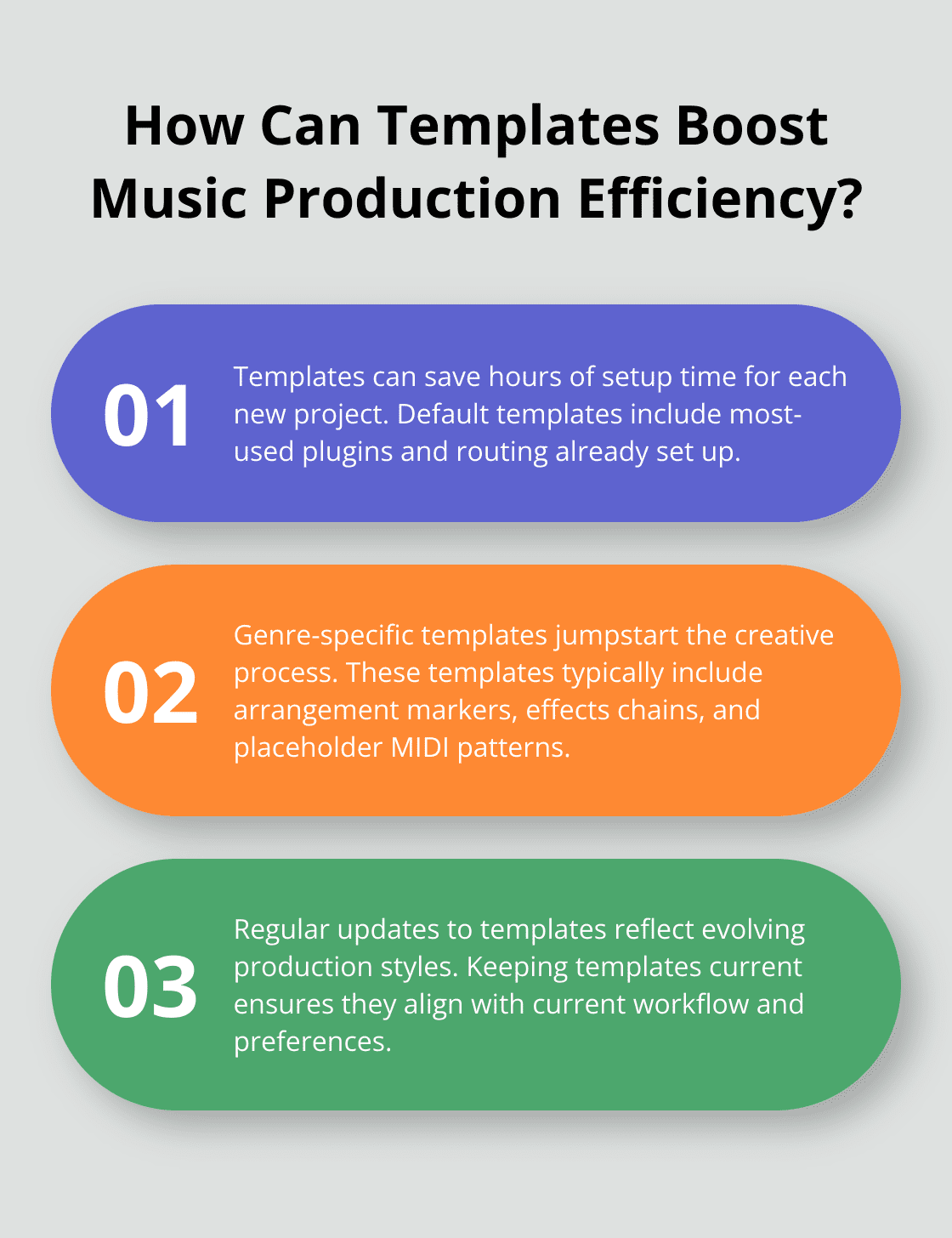
Name your files consistently. Use a format like “Artist Name – Track Name – Version Number” for project files. For samples, include key information like BPM, key, and type (e.g., “125 BPM – C Minor – Kick”).
Use color coding in your DAW to visually separate different elements. Assign specific colors to drums, bass, leads, and other track types. This visual organization helps you navigate complex projects quickly.
Leverage Templates for Rapid Production
Create a default template in your DAW with your most-used plugins and routing already set up. Include your go-to EQ, compressor, and effects on key channels like drums and vocals. This approach can save hours of setup time for each new project.
Build genre-specific templates. If you produce multiple genres, have a template for each to jumpstart your creative process. Include typical arrangement markers, common effects chains, and even placeholder MIDI patterns.
Update your templates regularly. As your production style evolves, ensure your templates reflect your current workflow and preferences.
Overcome Creative Roadblocks
Writer’s block affects every producer. One effective technique is the “20-minute rule”. Set a timer for 20 minutes and force yourself to work on your track, no matter how uninspired you feel. Often, this push is enough to get your creative juices flowing.
Try the “remix yourself” approach. Take elements from your older, unfinished projects and incorporate them into new ones. This can spark fresh ideas and give new life to abandoned work.
Collaborate with other producers. Websites allow you to share projects and collaborate remotely. Fresh perspectives can reinvigorate your creative process and teach you new techniques.
Implement regular “sound design sessions”. Develop ideas through jamming and build a track organically rather than trying to come up with a cohesive melody/hook first before jumping in.
An efficient workflow is personal. Experiment with these techniques and adapt them to suit your style. As you refine your process, you’ll find yourself producing more music, more effectively.
Final Thoughts
Music production advice for beginners emphasizes consistent practice and continuous learning. We encourage you to develop your unique sound by experimenting with various genres, techniques, and tools. Mistakes are valuable learning opportunities, so embrace them as chances for growth and improvement.
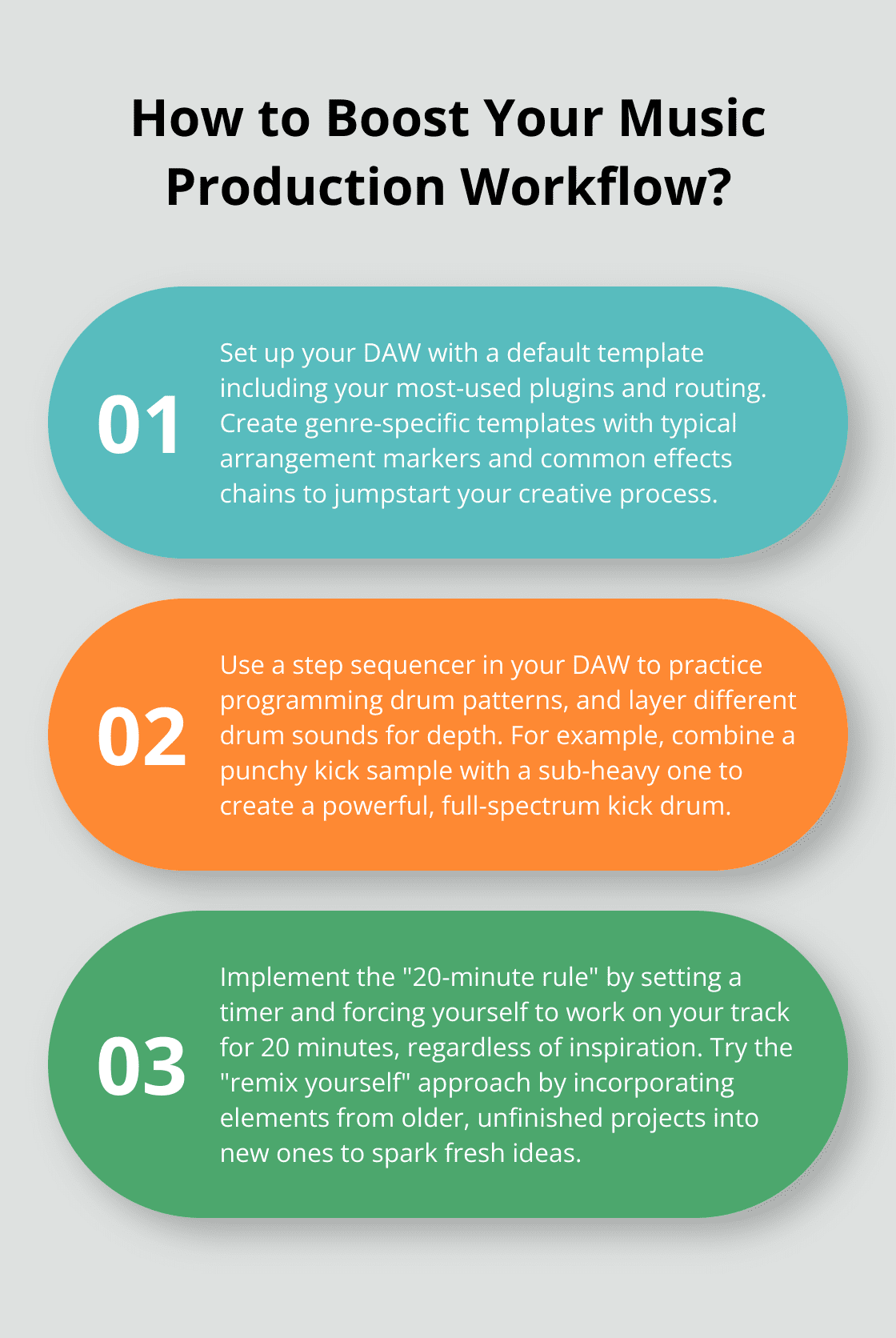
Stay curious and explore new aspects of music production to keep up with evolving technology and industry trends. Engage with online communities, attend workshops, and collaborate with fellow producers to expand your knowledge and network. At Edm, we offer comprehensive educational resources for aspiring electronic music producers to help you develop your skills systematically.
Becoming a proficient music producer requires time and dedication. Be patient with yourself and celebrate small victories along the way. With persistence and passion, you will create tracks that truly express your artistic vision.
